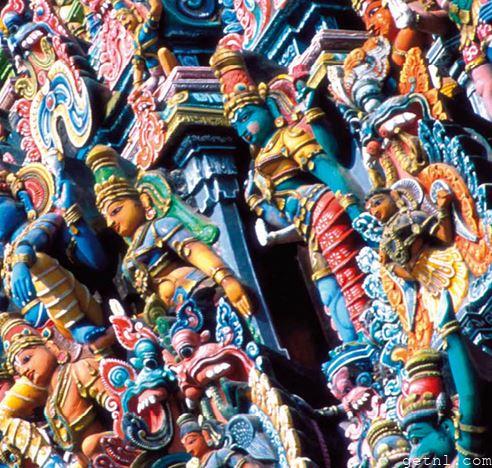The magic ofIndia, this most fascinating and colorful of countries, only begins with icons such as the Taj Mahal; a less conventional tour will reveal wonders of nature, artistry, and humanity in every corner of every state

NEED TO KNOW
LOCATION India is the largest country in South Asia, and has borders with Pakistan, China, Nepal, Bhutan, Bangladesh, and Burma. Its capital city is Delhi
POPULATION 1.1 billion
LANGUAGES 18 official languages are recognized (although hundreds are actually spoken), including Hindi in the north and Tamil in the south
When it comes to iconic images and unmissable attractions, India is a veritable tourist dream, and traditional tours of the country can feel as if they’ve been designed exclusively to yield a string of visual superlatives. On a typical journey you might travel from the bazaars of Old Delhi to the Taj Mahal and the great desert forts and palaces of Rajasthan, scouting for tigers in Ranthambore National Park en route. You might drift through the backwaters of Kerala, or tour the tea gardens of Darjeeling. Or follow the traditional temple trail to the world-famous shrines at Khajuraho or the ghats of Varanasi. All spectacular and unmissable, but also strangely one-dimensional.
The trouble with the great tourist attractions of India is that they’re just that. Visiting the Taj or the Varanasi ghats, you’ll be surrounded by fellow visitors as well as souvenir-wallahs, vendors, guides and opportunistic rickshaw drivers, all looking to make a quick buck.
In fact, there’s a great deal to be said for turning your back on the A-list sights entirely, and following an alternative route through the country. As soon as you get off the tourist trail your experience will be completely different – and probably a lot more enjoyable. Much of the fun of the place lies in simply being out in the streets, hanging out at local tea stalls, riding buses, meeting people, and experiencing the never-ending variety of life on display here.
Beauty, in India, is as much in the details as in the big sights: the sudden flash of a brilliantly colored sari in a dusty street; the quaint, hand-painted signs of a local bazaar; the smell of freshly ground spices drifting out of a market. As for the sights themselves, even the country’s “lesser” attractions are often every bit as fine as more-vaunted tourist destinations. You could start in the former colonial capital, Kolkata, then venture northeast to the wild, peaceful national park at Kaziranga – every bit as rewarding as the famous Ranthambore. From there, you might head northwest to follow the pilgrims up to the remote Himalayan village of Gangotri, before exploring the flamboyant desert towns of Shekhawati or the atmospheric abandoned city at Orchha, south of Delhi. The temples of Tamil Nadu, in the far south, are just as magical as those at Khajuraho. Best of all, you can probably visit all these without anyone trying to sell you a T-shirt or a model Taj Mahal with a built-in alarm clock.
FORGET INDIA’S TOURIST TRAIL?
THE BUILD-UP India is one of the most remarkable and captivating countries in the world: a constant festival of color, crowds and organized chaos; sometimes maddening, and often plain mad, but never dull.
THE LETDOWN Rushing around iconic sights, getting on and off a tour bus and only meeting the Indians who work in your hotel or who try to sell you a carpet or a toy elephant leaves many visitors feeling like a piece of cargo. If you stick exclusively to the big tourist attractions, you are likely to see India at its worst.
DOING IT ANYWAY? India is more like a continent than a country, so concentrate on one particular area and try not to rush.
Enjoying it in small bites – a state or two at a time – will give you the chance to get the most out of the place and meet the people who make it so interesting. Ensure you mix in one or two less well-known destinations along with the major tourist attractions.
PRACTICAL INFORMATION
Entry Requirements All visitors require a visa, except citizens of Nepal and Bhutan.
When to Go The best time to visit most parts of the country (apart from the Himalayas) is during the cool, dry months from November to March. The monsoon arrives on the south coast around June, and then sweeps up the country, taking around a month to reach Delhi. It lasts until September.
Air Travel
India has an extensive and continually expanding network of domestic flights run by about ten local airlines. You can now fly to virtually every corner of the country. Fares on busier routes can be a real bargain. Those to more unusual destinations can be relatively pricey.
Train Travel
India’s legendary railway system (42,000 miles/67,000 km of track, 14,000 locomotives and around 12 million passengers daily) covers almost every area of the country, apart from the mountains, and even today is often the quickest and most comfortable way to get around. You have various travel options, from a private, air-conditioned first-class compartment to a packed third- class carriage with wooden bench seats. Fares are inexpensive, especially in second and third class.
Road Travel
Buses go absolutely everywhere, though they’re generally less comfortable than the trains, and the driving can be rather hair- raising at times. Arranging a car and driver is relatively affordable.
Given the fairly chaotic roads, few visitors drive themselves.
Climate
The climate varies greatly in India: temperatures soar in the Gangetic Plains of the north, though the Himalayan belt remains cool; the center and south have a tropical monsoon climate; and the coastal belts are humid and warm.